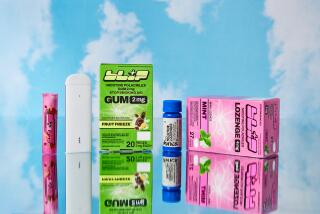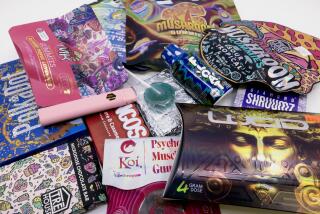What Will Tobacco Firms Think of Next?
The Aztecs might turn in their tombs if they found out their sacred smokes have become the focus of fickle marketing campaigns, calculating packaging and fashion-conscious puffing.
Ironically, it’s a back-to-roots cigarette, American Spirit, that kicked off a new generation of tobacco--”microsmokes.” American Spirit, a small brand with a distinct taste, pays homage to the first cigarettes by using only natural ingredients.
“I heard through word of mouth that American Spirit were additive-free,” says actress Elizabeth Rainey, 27. “That intrigued me.”
Indeed. But we all know how things go. As soon as a “product” becomes halfway successful, especially with a buzz market of younger smokers, along come the bigwigs, boasting back-to-basics products of their own. So along with microsmokes such as American Spirit, Buz, Gunsmoke and Magic Herbal, we have the new Moonlight Tobacco line from R.J. Reynolds Tobacco Co. and Dave’s from Philip Morris U.S.A.
Microsmokes, which often cost more than mainstream brands (typically 25 to 50 cents more per pack), aren’t the only alternative cigarettes gaining the hearts and lungs (literally, say smoking critics) of the young. Designer and foreign smokes--Dunhill, Cartier, Galoises, Gitanes, Peter Stuyvesant, Export A, clove cigarettes and beedies from India--are also proving more popular.
Critics contend microsmokes are clearly aimed at younger smokers--from the hip packaging to the test marketing, which is often conducted in Seattle, a hotbed of youth culture. Scott Ballin, spokesman for the American Heart Assn., says this marketing includes “youthful, creative, stylish campaigns that can tap into the young adult market.”
R.J. Reynolds spokesman Frank Lester counters: “We market all of our products to the 21-plus segment.”
The microsmokes phenomenon, which makes up less than 1% of the $47-billion U.S. cigarette market, is sometimes compared to the small but growing microbrewery beer market. As with beer, where mass-production breweries have put out beers made to look like they come from small-town Oregon, mass-production cigarette companies have, with these new products, put out their own faux microsmokes, sometimes with humorous reactions.
Rainey and other young smokers say they won’t be duped by the deceitful smokes. “It seems like a joke--like Red Dog beer,” she says, referring to a faux microbrew produced by Miller Brewing Co., which is owned by none other than Philip Morris Companies.
Beedies, on the other hand, are far from being a product of corporate America. The joint-sized, leaf-wrapped tobacco smokes are often smuggled into the United States from India. They are popular enough that both U.S. Customs and the State of California have investigations underway aimed at catching illegal importers. The State Board of Equalization, which taxes imported cigarettes on top of U.S. Customs duties, seized 440,000 untaxed beedies this fall in the Bay Area. “Legitimate sellers are complaining that their business is hurting because of smuggling,” says state tax official Monte Williams.
Pink packages of 25 beedies can be had for about $1.25 at some mom-and-pop liquor stores on the Westside, stores throughout the region that cater to Indian customers and even some cash-and-carry warehouses. “They give you a head rush,” says one liquor store owner who sells smuggled beedies.
Then there’s Buz, a microsmoke launched this month. It doesn’t promise a buzz, but it does provide an unusual taste. “Basically the Buz name comes from a product that honeybees make, propylus,” says John Gallahan, chief operating officer of Star Tobacco Co. of Petersburg, Va., which owns Buz. “We own the patent to using propylus with tobacco, which gives Buz it’s unique flavor.
“Buz contains 100% natural tobacco,” he adds, “so we have the same strategy that American Spirit has.”
Everyone, it seems, is chasing American Spirit. Sales of the cigarette, says owner Santa Fe Tobacco Co., have consistently grown since its launch 10 years ago. Santa Fe President Robin Sommers has called American Spirit tobacco “pure, unadulterated leaves, grown in the good earth, emblematic of rites as old as the Indians themselves.”
*
The growing popularity of Spirit and brands like it play off a variety of factors, ranging from the popularity of the all-natural cigar to increasing demand for healthier products--especially in light of recent revelations that tobacco companies add several unsavory chemicals to their cigarettes.
“Obviously, cigars have been a fascination for people, and we’re starting to see that trickle down to our products,” says Tom Byelick, marketing manager for the company that imports Dunhill, Cartier and several other brands of cigarettes to the United States.
In 1994, National Public Radio uncovered a list of chemicals added to mass-market cigarettes, including chlorofluorocarbons, Freon and a substance once considered for use in chemical warfare. The report sent shock waves through the smoking world and provided a bigger market for chemical-free cigarettes like American Spirit and Buz.
“I want the most pure cigarette I can get,” says 31-year-old Doug Smith, an Export A burning between his fingers on a recent night at the Dresden Room lounge in Los Feliz.
Philip Morris is tapping into the microsmoke trend with Dave’s, a cigarette line the company began test marketing in Denver, Seattle and Portland this fall. The smokes stand apart, the company says, mostly in terms of packaging and marketing. They do not boast of all natural ingredients. Packs contain an insert that tells the “tale of a fictional underdog, Dave, who creates his own tobacco company,” says a representative.
R.J. Reynolds’ entry into the market came last summer in the form of six brands of cigarettes--Sedona, Jumbo, Politix, Metro Lights, City and B--marketed in New York, Chicago and Seattle under the Moonlight Tobacco Co. label. Again, the main difference between these and other mass-market cigarettes, a representative says, is the packaging and marketing.
“The idea is that cigarettes as a consumer product really have not changed in a long time,” says R.J. Reynolds’ Lester. “Red for full flavor, green for menthol. The packaging has not changed.”
*
Until now. And that has some critics of smoking concerned.
The tobacco industry has for several years been searching for new markets to bolster sales. The specter of anti-smoking activism and looming legislation (to ban cigarettes from being sold in vending machines, for example) has the industry against the ropes. One new target has been exports. But new, younger smokers are also a must, analysts say.
Statistics show that eight out of 10 smokers start by age 18. Last year, in fact, smoking increased among high schoolers, with more than six out of 10 reporting they have smoked a cigarette, almost twice the number of teen smokers in 1993, according to a University of Michigan study. What’s more, the biggest influence drawing kids to cigs is . . . you guessed it, marketing, according to a study last fall (a study the industry challenges).
“Tobacco marketing is much stronger than peer pressure,” UC San Diego’s John Pierce, co-author of the study, told reporters in October.
But despite the attraction to smoking among the young, there is little evidence so far that any of these brands, with the exception of veteran American Spirit, are burning up the mainstream competition.


